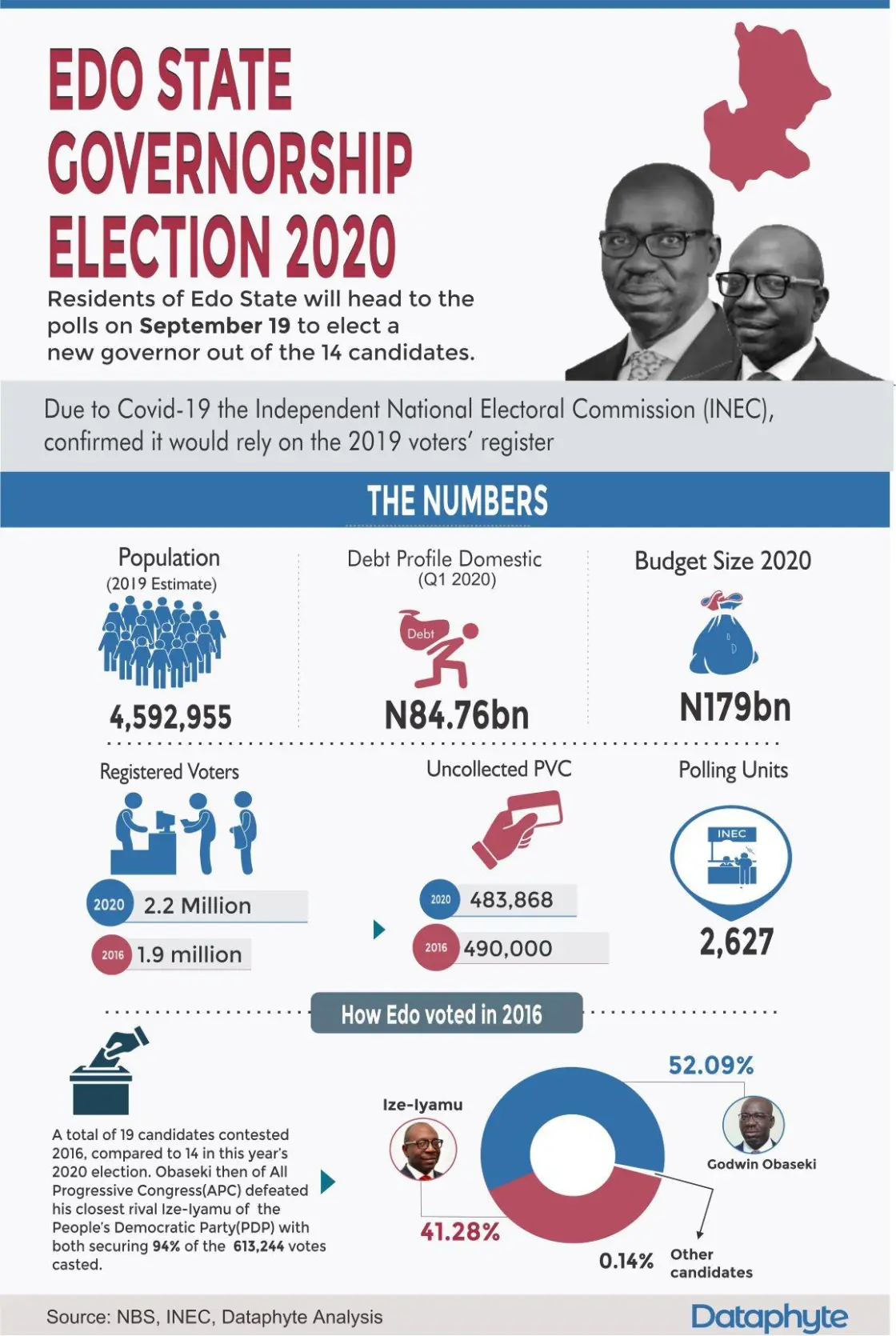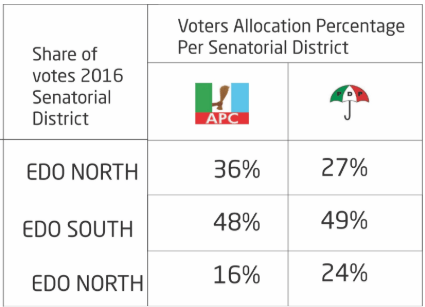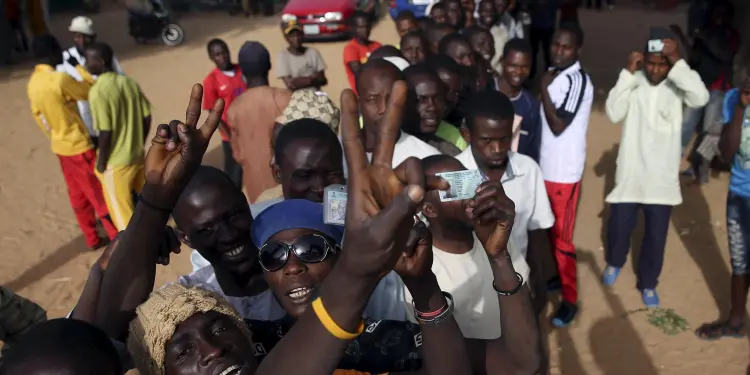For candidates vying for the Edo State governorship position, slated for September 19, less than 40 days away this month represents an important phase in the race to be at the helm of affairs.
Already, anxious citizens have begun permutations on the election outcomes; alternatively candidates of the various political parties jostle to curry favour with their agendas for the approximately 5 million residents of the state.
According to the Independent National Electoral Commission (INEC), there are 14 political parties, 12 of the 14 governorship candidates are male, leaving two females.
The commission on its websites listed the candidates as Obhafuoso Paul for Action Alliance (AA); Akhigbe Ehiabhi for the African Democratic Congress (ADP); Ibio Emmanuel for Action Democratic Party (ADP); Osagie Ize-Iyamu for the All Progressives Congress (APC).
Others are Lucky Idehen for All Progressives Grand Alliance (APGA); Igbineweka Osamuede for the Allied Peoples Movement (APM); Amos Osalumese Areloegbe for All Peoples Party (APP) and Osifo Uhun-Ekpenma for the Labour Party (LP).
For the Nigerian People’s Party (NPP), Agolebun Tracy is the Governorship Candidate; Stevie Ozono will be the flag-bearer for National Rescue Movement (NRM); incumbent governor of the state Godwin Obaseki will contest under the Peoples Democratic Party; Jones Osagiobare will challenge under the Young Progressive Party (YPP) and Zenith Labour Party (ZLP) will have Akhalamhe Amiemenoghena as its Governorship candidate.
To understand the dynamics ahead of the forthcoming governorship election in the state, Dataphyte crunched the data of previous elections held since 1999.
Break from the past in Numbers (1999-2012)
Since Nigeria returned to democracy in 1999, we’ve witnessed “blistering battles” on who “held power” in the country; Edo State has consequently had its own fair share.
In 1999, the State’s first gubernatorial polls saw the emergence of Lucky Igbinedion under People’s Democratic Party (PDP), defeating Dan Orbih of the All People’s Party (APP).
Interestingly, Igbinedion also contested the annulled 1992 elections, pulling a vote of 556,871 from the total valid votes of 737,198 to defeat its closest rival, APP with 249,688 votes; AD had 8995 votes.
We see this feat again in the 2003 elections, where Igbinedion topples opponents with a staggering 969,747 votes. The 2003 polls had 1,432,891 total registered voters with 78 percent voter turnout, a 3.8% jump from the previous elections- 1,380,418.
The 2007 polls remain the toughest gubernatorial elections in the state, per observers. There were not only cases of violence, but various conflicting results prevalent. In fact, the electoral commission cancelled two local government areas leading Professor Oserheimen Osunbor of the PDP’s victory stint. Come 2008, however, the electoral tribunal annulled the results leading to former trade union leader, Adams Oshiomhole’s victory. In typical fashion, the Action Congress flag-bearer had reportedly sought redress through protests in the state. The tribunal chairman, Justice Peter Umeadi, held that Oshiomhole polled a total 166,577 votes as against Osunbor’s 129,117 votes who had previously garnered 329,740 votes.
Prior to the 2007 polls, voter registration had dropped by 6 percent, ahead of the presidential and governorship elections, according to INEC figures. The February 14, 2007 election data represented voter interest at 1,345,410 as against 2003’s 1,432,891. This may not be unconnected with the bumpy nature of the polls.
There was, however, an increase in voter registration by 2012. Despite this increase, to the tune of 1.6 million, accredited voters were a measly 667,993 representing a significant 41 percent drop in voters’ turnout. We recall a similar trend with the election that recorded a 32% voter turnout.
Oshiomole now with All progressive Congress (APC), recorded a landslide victory with 477,478 votes to defeat five other candidates in the election; the closest rival, Maj Gen Charles Airhiavbere of Peoples Democratic Party (PDP) polled 144, 235 votes.
Oshiomole played a major role in the 2016 gubernatorial election that ushered in Godwin Obaseki.
Not only did her handpick Obaseki as the flag-bearer, he campaigned vigorously for Obaseki’s bid in 2016. Obaseki’s victory was a very close race. He won with 319,483 votes ahead of Osagie Ize-Iyamu of the PDP who garnered 253, 173 votes; thus falling behind by 66,310 votes.
The election, however, recorded widespread voters’ apathy. While INEC figures put registered voters in Edo State at 1,900, 233, only 622,039 voters turned up; leaving the total valid votes cast in the contest at 613, 244.
2016 Vote distribution by local government
Voter apathy has become mainstream in Nigeria. And, in all honesty, expecting a repeat of the preceding in the incoming elections is well within reason.
If the assumption that all registered voters from 2016 vote, interesting figures lie ahead of September elections.

Breakdown
Edo State comprises eighteen (18) Local Government Areas (LGAs) divided into three senatorial districts, namely Edo North, Edo South and Edo Central. And before the 2016 polls, there were 2,627 Polling Units (Pus) and 4,011 Voting Points (VPs).
Of the 18 local government areas, Obaseki, APC’s flag bearer won in 14 of the 18 local governments, viz: Owan West; Egor; Igueben; Uhunmwonde; Oredo; Owan East; Ovia North East; Etsako East; Etsako Central; Etsako West; Ikpoba-Okha; Akoko-Edo; Ovia South-West; Owan East.
Alternatively, PDP’s governorship candidate, Ize-Iyamu secured Esan North East, Esan South East, Orhionmwon and Esan Central local governments.
A further breakdown of the figures showed that APC won the North and South Senatorial Districts, while PDP won the central senatorial district.
Voters allocation percentage per senatorial district for both parties

Interestingly, the 2019 presidential election breaks away from trend from the last three previous elections (2003, 2007, 2016) in the state.
Although the APC ruling party represented the Edo state government, during the presidential elections, PDP won Edo state with 275, 842 votes over APC’s 267,842 votes. Why did this happen? Your guess is as good as ours. For some, it reflects the heightened nature of malpractice in gubernatorial elections over presidential elections. Others affirm malpractice is the order of the day, nationally; so it remains unclear.
An impressive manifesto won’t ensure good governance
We’ve heard the saying paraphrased that “a great wedding won’t ensure a good marriage.” Similarly, impressive rallies and propaganda are not a ticket to good governance.
The series of sloganeering will surprise no one familiar with the political landscape in Nigeria, with candidates already issuing promises.
In 1999, Lucky Igbinedion’s victory spurred palpable optimism amongst indigenes; it was as the transition they’d hoped for. His campaign name, “Reality 1999”, reiterated in his inauguration speech stated he would develop the state; or so they thought.
However, by the time Igbinedion was leaving office in 2007, not only did he plead guilty on accounts of embezzling N2.9 billion, his successor, Oserheimen Osunbor, accused him of leaving the state with a debt of N11 billion.
Recall Adams Oshiomhole (2008) rode on the wings of free and qualitative education; functional healthcare; resuscitation of sports and ensuring security of life and property. Well, his exodus in 2016 left Edo state with a debt profile of N45 billion, per the National Bureau of Statistics (NBS).
Similarly, in 2016, Obaseki promised to create 200,000 jobs in 4 years through economic revival, promoting local businesses and providing highly skilled talent in Edo State. However, the latest NBS unemployment figures revealed a 25.1% increase as at the third-quarter, 2018 from 19.6% in the same quarter of the previous year. And as at June 2020, the state’s domestic debt increased to N84.76.
2020 another year of promises
Just as in previous elections, the 2020 election features candidates’ promises.
Already, the campaign promises have kicked off. The two dominant parties- PDP and APC- have already released various agendas to placate the 2.2 million registered voters in the state. For Obaseki, it is a promise to make the state, the business and economic hub of the country, upon re-election.
Using the theme Make Edo Greater Again, Obaseki said top on the list is the restoration of electricity in the state and aggressive reform agenda for “Technical and Vocational Education and Training (TVET).”
As for Ize-Iyamu who managed the 1999, 2003 and 2012 campaigns of Lucky Igbinedion and Oshiomhole’s, he promises employment generation, with an emphasis on the Benin Water Storm project; per his agenda, it would check flooding in the state.
However, the decision remains with balloters to move beyond sentiment and make informed decisions.




